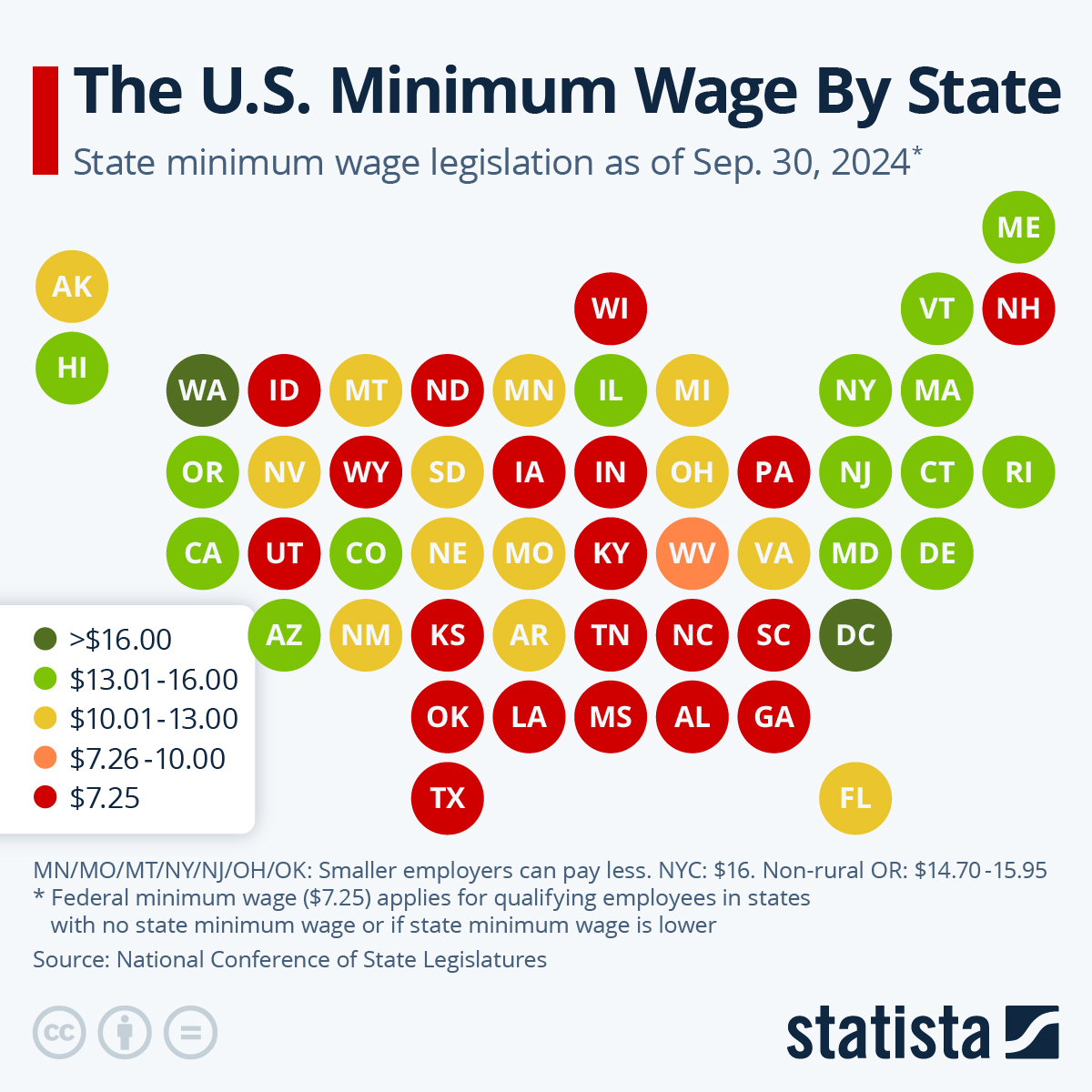Federal Minimum Wage: Only About One Percent of Hourly Workers
by Katharina Buchholz,
Sep 1, 2025
The federal minimum wage in the United States has stood at $7.25 an hour since 2009. Today, this rate still applied across 20 U.S. states, most located in the country's South, Midwest and Rocky Mountain region. In the remaining 30 states, minimum wages have risen and continue to do so, opening up a gap between these states and those applying federal minimum wage.
According to the Bureau of Labor Statistics, 80.3 million workers age 16 and older earned an hourly wage in 2024, of which 843,000 earned federal minimum wage or below. This is down from a high of 4.4 million in 2010, as several states introduced higher minimum wages in the meantime and some cities have also introduced their own minimum wages, diverging from state laws. Additionally, the fact that the minimum wage hasn't changed in so long means that going rates for lower-skilled workers have increased to somewhat above the prescribed minimum in many cases, aided by the post-Covid hiring crunch when employers had to offer more to find workers. Today, only around 1 percent of hourly workers earn the federal minimum, while almost a quarter of the U.S. workforce makes less that $17 an hour.
Those working in food preparation and serving are most often earning minimum wage or below. This is due to many states carving out exceptions for tipped workers (where technically, hourly wages and tips then have to reach the minimum). Low-skilled office support as well as personal care and services work also saw many make below minimum wage, as several more exceptions apply across states, for example in small businesses, part-time youth and seasonal work and more. Also, the Fair Labor Standards Act of 1938, which introduced federal minimum wage in the U.S., does not apply to all occupations, with some retail, service, office and agricultural as well as domestic service employees exempt. Exceptions also apply for public servants in some instances.
Women in the United States were more likely to work for minimum wage or below, with the rates of female Black and Asian minimum wage workers especially high. While 0.8 percent of male hourly workers earned minimum wage or below last year, this number was 1.3 percent for women. Minimum wage jobs affected different races and ethnicities more equally. Texas is the state with most workers at minimum wage or below (120,000), followed by Ohio (48,000), Pennsylvania (47,000) and Florida (46,000). In California and New York, there were 38,000 of these workers last year each.
 You will find more infographics at Statista
You will find more infographics at Statistaby Katharina Buchholz,
Sep 1, 2025
The United States is made up of a patchwork of minimum wage laws with 30 states and D.C. having a rate higher than the federal minimum of $7.25 per hour. This is according to the National Conference of State Legislatures. California's current rate of $16.50 ranks towards the top of the country and is only surpassed by the minimum wages of Washington and Washington D.C., while being matched by New York City and closely followed by rates in Connecticut and the Portland metro area. The federal minimum wage was first introduced under the Fair Labor Standards Act of 1938 which also established overtime and child labor standards for full-time and part-time workers.
Across the country, five U.S. states have not adopted a minimum wage - Alabama, Louisiana, Mississippi, South Carolina and Tennessee. Another two, Georgia and Wyoming, have a minimum wage below the $7.25 federal minimum. In all seven of those states, the federal minimum of $7.25 per hour applies in accordance to the Fair Labor Standards Act, even though there are exceptions to its coverage. 13 more states have a minimum wage identical to the federal minimum wage, bringing the number of states where minimum wage workers earn only $7.25 per hour to 20. A handful of states, among them New Jersey, Georgia, Illinois and Ohio, also carve out exceptions for smaller employers and there are several more exceptions from minimum wage depending on the state.
While some U.S. states have been increasing their minimum wage rates in recent years - some by quite a bit to battle real wage decline due to inflation - federal minimum wage states have been at a standstill since the last U.S. federal minimum wage increase in 2009. This is resulting in the gap between different U.S. minimum wages growing increasingly larger, with the ones currently closest to the nationwide rate of $7.25 being West Virginia's $8.75 and Montana's $10.55.
But there have also been headwinds for minimum wage. California voters last year rejected a ballot measure to increase the state's minimum wage from then $16 to $18 an hour. The question was posed during the U.S. election on November 5, but the results were only finalized two weeks later due to the narrow margin of the measure's defeat. The result was an unexpected one in a blue state like California, but also fell in line with other election results from this year, like Californians voting to reverse parts of criminal justice reform and deciding not to ban forced prison labor.
 You will find more infographics at Statista
You will find more infographics at Statista